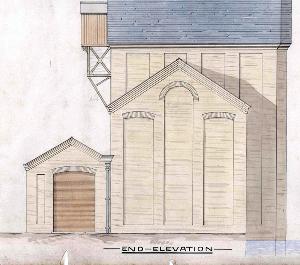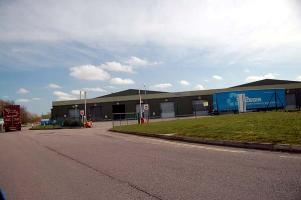South Mills

Front elevation of new South Mills by John Usher in 1873 [CDE2/1]
In the Domesday Book of 1086 Chalton was held by Adeliza, wife of Hugh de Grandmesnil. Her manor included a mill and it seems a reasonable guess that this mill was at, or at least near, the modern South Mills.
In 1679 the Manor of South Mills, including the mills, was sold by Thomas Cheyne to Thomas Bromsall and in 1682 South Mills, alias Sow Mills was conveyed by Ralph to his brother John under the terms of their father's will [X612/12-13]. The history of ownership of the mill would have followed that of the Manor of South Mills.
The terrier of the holdings of the Earls of Kent at Blunham [L33/285] shows that the Bromsall family still owned South Mills in 1719 but by 1784 Robert Thornton was the owner as Bedfordshire & Luton Archives & Records Service has a sale catalogue of that year [PM1868] in which he sold: "A water Grist-Mill, with two Wheels that work three Pair of Stones; the Tolls upon all Barges and other Craft passing the Lock; a dwelling-House, with various Out-Buildings, Yard and Garden, and two Closes of inclosed Meadow Land, containing Six Statute Acres, one Rood, and seventeen Perch, and Nine computed Acres, one Rood, of Open Field, Arable and Meadow Land, making together Fifteen Acres, two Rood, and seventeen Perch; in the Possession of Mr. Henry Dobson, on Lease, which expires at Michaelmas, Old Stile [sic], 1785, at £51".
The whole estate, including the mills, was bought by Robert Thornton's brother Godfrey, who died in 1805 and was succeeded by his son Stephen. In 1844 Stephen Thornton leased the water corn mills called South Mills to Biggleswade bankers William Hogg and Robert Lindsell for twenty one years [HF41/2/1/15]. It was common practice for the tenant miller to own the fittings of the mill and in 1852 the sub-tenant miller Mark John Norman took out a mortgage with Hogg and Lindsell secured on the mill machinery [HF41/2/1/16]. Interestingly in 1813 William Norman had rented Blunham Mills [qv] downstream from South Mills for twenty one years.
An inventory of South Mills was taken on 26 Mar 1852 as part of the mortgage arrangements [HF41/2/1/18] and the description is as follows, please note that the spelling is eccentric and inconsistent to say the least:
"The upstream Mill is a Cast Iron Bevell Mortise Pit wheel geared with oak logs a Cast Iron Waller [Wallower] to work in the same, Cast Iron upright shaft with Budgin [Bridging] Box at the Bottom and Peddestall and Brasses at the top of the same".
"The downstream Mill a sixteen feet Water Wheel with cast Iron arms two wood Rims a Cast Iron shaft with four Pedestals, Brasses, Coupling Box and Bolts &c as fixed. Cast Iron Bevel Mortise Pit Wheel Geared with oak logs a Cast Iron Wallower to work in the same three pair of four feet four Inch punch stones, three stone cases, Hoppers, hopper ladders &c, three wrought Iron Spindles Mases [maces] & centre Bars, two cast Iron Spur pinions one wood with three cast Iron neck Boxes with brasses screws &c, three cast Iron Bridging Boxes with brasses screws &c, three fixd [?] spindles, two sets of raising Irons for raising pinions out of Gear, Flour Machine Cylinder with barrel Brushes cast iron Wheels and Drum at the Head and strap for driving the same".
In 1853 Charles Powers took the lease of South Mills [HF41/2/1/22]. He used the mills to produce oil cake rather than flour. In 1857 the Mogerhanger Estate, including South Mills was put up for sale by the executors of the late Godfrey Thornton [WG2539]. South Mills was sold off and then purchased from the new owners by Charles Powers in 1859 [HF41/2/1/26].
Charles Powers died in 1873 and the trustees of his will put his nephew Edward Frederick Powers in as manager of what was now called Charles Power & Company. A fire occurred at the mills in the year of Charles' death which caused their complete destruction. The drawings accompanying this article are by Bedford architect John Usher (who had been born in Blunham in 1822) for the replacement mill buildings and photographs taken just before the mills were demolished in the late 20th century show that the plans were adhered to.

Side elevation of new South Mills by John Usher in 1873 [CDE2/1]
Frederick Edward's brother Hugh E. became a sleeping partner in Charles Powers & Company in 1880 and did nothing to restrain the dangerous practice his brother developed of speculating in oil cake from abroad. The company owned not just South Mills but Biggleswade Mills, Holme Mills and Langford Mills but in 1884, as a result of poor speculation and swindles it went bankrupt. The firm continued in administration for some years as attempts were made to mortgage or sell the mills which eventually came to fruition in 1899 when Charles Beeson bought them, his entry in Kelly's Directory for 1903 reads "chemical manure manufacturer, bone mills and horse slaughterer", the mills were obviously now being used to grind up animal bone for fertiliser. Directories reveal that by 1914 the firm was being run by the executors of Charles Beeson, the firm becoming Beeson brothers by 1920 and were still at the Mills in 1940, the date of the last Kelly's held by Bedfordshire & Luton Archives & Records Service.
Bankruptcy is sad but the death of a child is even more so. On 9 Jul 1921 Alexander Cheverton, a choirboy at Blunham church, had drowned at the mills. He was most likely the son, or similarly close relative, of William Cheverton who is listed as a leather dresser (to begin with as W.Cheverton & Company, latterly just as William Cheverton) at South Mills for most of the early 20th century.
/ChaltonImages/South Mills on a map of 1902 annotated in 1927.jpg)
South Mills on a map of 1901 annotated in 1927
The Rating and Valuation Act 1925 specified that every piece of land and building in the country was to be assessed to determine the rates to be paid on it. South Mills was valued in 1927 and the valuer noted [DV1/R47/68] that Beeson Brothers were owners as well as occupiers of the mills. The valuer commented: "Shown around by Mr. Beeson. Ought to be on the coast at a port - all the new materials, potash etc. comes from overseas. Old Mill was empty for years. Bought by them 1900. Not therefore a very convenient building for the trade. Too much upstairs work, 4 floors and attic - big disadvantage. Put in Electric Light. water wheel a heavy, expense. New water gates cost £400-£500".
He noted that the buildings were brick and slate and "well built". The main building (A) on the annotated map above, had a mill floor with a loading door, brick floor, boiler room ("not used") and another boiler room used for salting hides. There was a dynamo room ("supplies light only") and the water wheel, which produced 20 horsepower, though ten was enough and was "not often used". A store room completed the ground floor.
The first floor was the meal floor. The second floor was the bone storage floor and the third floor the drying floor with rooms measuring 22 feet by 38 feet; 14 feet by 40 feet; 60 feet by 41 feet 6 inches and 28 feet by 18 feet.
A second building (B on the map above), of brick and slate with a concrete floor had a two bay store room ("Has Railway Track Through it") and was "just a shell" but was a "good storage building". It also had a twenty ton weigh bridge measuring 65 feet 6 inches by 62 feet. A third building (C) was a boiler house measuring 26 feet by 29 feet with a Robey & Company boiler "used for steam only. Horizontal type. Very poor". The fourth building (D) was a licensed slaughter house measuring 47 feet by 29 feet. The building annotated E on the map was a lean-to store of 36 feet 6 inches by 28 feet 6 inches and F was a 15 feet by 30 feet offal store. Building G was a three bay open store of 50 feet by 28 feet made of wood and corrugated iron. H was a store ("gets flooded") with an earth floor with a concrete floored lean-to at the side. The main building measured 69 feet by 74 feet. Finally, the building annotated J was a small store measuring 20 feet by16 feet and an office measuring 16 feet square.
In his final comments the valuer stated: "Buildings are very badly arranged and only partially used". He further noted that in Building A the first and second floors had a serious health and safety concern as they were "only approached by a very poor wooden stairway" and the whole place flooded badly.
The buildings annotated C208/2 on the map above were part of the mills complex. They were a timber and tile range comprising two store sheds, a stable for two horses, a mixing shed, a cow shed with a tie-up for four beasts and another with a tie-up for two and a harness room. 37.296 acres of land went with the mills including gardens, an orchard and osier beds.

Abbey Corrugated works at South Mills in March 2007
Usher's spendid mill buildings were demolished in 1966 and the site at the time of writing [March 2007] is occupied by a firm called Abbey Corrugated Limited, a corrugated sheet manufacturer with another site in Kettering [Northamptonshire] and forming part of the D.C.Smith Plc group of companies.